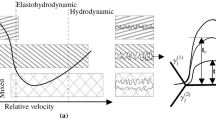Abstract
Soft elastohydrodynamic lubrication (EHL) problem is studied for a reciprocating elastomeric seal with full account of finite configuration changes. The fluid part is described by the Reynolds equation which is formulated on the deformed boundary of the seal treated as a hyperelastic body. The paper is concerned with the finite element (FE) treatment of this soft EHL problem. Displacement-based FE discretization is applied for the solid part. The Reynolds equation is discretized using the FE method or, alternatively, the discontinuous Galerkin method, both employing higher-order interpolation of pressure. The performance of both methods is assessed by studying convergence and stability of the solution for a benchmark problem of an O-ring seal. It is shown that the solution may exhibit spurious oscillations which occur in severe lubrication conditions. Mesh refinement results in reduction of these oscillations, while increasing the pressure interpolation order or application of the discontinuous Galerkin method does not help significantly.
Similar content being viewed by others
References
Adams M, Briscoe B, Johnson S (2007) Friction and lubrication of human skin. Tribol Lett 26: 239–253
Alart P, Curnier A (1991) A mixed formulation for frictional contact problems prone to Newton like solution methods. Comp Methods Appl Mech Eng 92: 353–375
Almqvist A, Dasht J (2006) The homogenization process of the Reynolds equation describing compressible liquid flow. Tribol Int 39: 994–1002
Baumann C, Oden J (1999) A discontinuous hp finite element method for convection-diffusion problems. Comp Methods Appl Mech Eng 175: 311–341
Dowson D (1995) Elastohydrodynamic and micro-elastohydrodynamic lubrication. Wear 190: 125–138
Dowson D, Higginson G (1977) Elasto-hydrodynamic lubrication. Pergamon Press, New York
Hamrock B, Schmid S, Jacobsen B (2004) Fundamentals of fluid film lubrication, 2nd edn. Marcel Dekker, New York
Hughes C, Elcoate T, Evans H (1999) A novel method for integrating first and second order differential equations in elastohydrodynamic lubrication for the solution of smooth isothermal, line contact problems. Int J Numer Methods Eng 44: 1099–1113
Jai M, Bou-Said B (2002) A comparison of homogenization and averaging techniques for the treatment of roughness in slip-flow-modified Reynolds equation. Trans ASME J Tribol 124: 327–335
Jones M, Fulford G, Please C, McElwain D, Collins M (2008) Elastohydrodynamics of the eyelid wiper. Bull Math Biol 70: 323–343
Korelc J (2002) Multi-language and multi-environment generation of nonlinear finite element codes. Eng Comput 18: 312–327
Korelc J (2006) AceGen and AceFEM user manuals. http://www.fgg.uni-lj.si/Symech/
Korelc J, Wriggers P (1997) Improved enhanced strain four-node element with Taylor expansion of the shape functions. Int J Numer Methods Eng 40: 407–421
Lu H, Berzins M, Goodyer C, Jimack P (2005) High-order discontinuous Galerkin method for elastohydrodynamic lubrication line contact problems. Commun Numer Methods Eng 21: 643–650
Lu H, Berzins M, Goodyer C, Jimack P, Walkley M (2006) Adaptive high-order finite element solution of transient elastohydrodynamic lubrication problems. Proc Instn Mech Engrs Part J: J Eng Tribol 220: 215–225
Müller H, Nau B (1998) Fluid sealing technology, principles and applications. Marcel Dekker, New York
Nau B (1999) An historical review of studies of polymeric seals in reciprocating hydraulic systems. Proc Instn Mech Engrs Part J: J Eng Tribol 213: 215–226
Nikas G (2003) Elastohydrodynamics and mechanics of rectangular elastomeric seals for reciprocating piston rods. Trans ASME J Tribol 125: 60–69
Nikas G, Sayles R (2004) Nonlinear elasticity of rectangular elastomeric seals and its effect on elastohydrodynamic numerical analysis. Tribol Int 37: 651–660
Oh K, Rohde S (1977) Numerical solution of the point contact problem using the finite element method. Int J Numer Methods Eng 11: 1507–1518
Patir N, Cheng H (1978) An average flow model for determining effects of three-dimensional roughness on partial hydrodynamic lubrication. Trans ASME J Lubr Technol 100: 12–17
Pietrzak G, Curnier A (1999) Large deformation frictional contact mechanics: continuum formulation and augmented Lagrangian treatment. Comp Methods Appl Mech Eng 177(3–4): 351–381
Prati E, Strozzi A (1984) A study of the elastohydrodynamic problem in rectangular elastomeric seals. Trans ASME J Tribol 106: 505–512
Ruskell L (1980) A rapidly converging theoretical solution of the elastohydrodynamic problem for rectangular rubber seals. Proc Instn Mech Engrs Part C: J Mech Eng Sci 22: 9–16
Salant R, Maser N, Yang B (2007) Numerical model of a reciprocating hydraulic rod seal. Trans ASME J Tribol 129: 91–97
Schellekens J, de Borst R (1993) On the numerical integration of interface elements. Int J Numer Methods Eng 36: 43–66
Souza Neto E, Perić D, Dutko M, Owen D (1996) Design of simple low order finite elements for large strain analysis of nearly incompressible solids. Int J Sol Struct 33: 3277–3296
Stupkiewicz S, Marciniszyn A (2009) Elastohydrodynamic lubrication and finite configuration changes in reciprocating elastomeric seals. Tribol Int 42: 615–627
Vicente J, Stokes J, Spikes H (2005) The frictional properties of Newtonian fluids in rolling–sliding soft-EHL contact. Tribol Lett 20: 273–286
Wriggers P (2002) Computational contact mechanics. Wiley, Chichester
Wu S (1986) A penalty formulation and numerical approximation of the Reynolds-Hertz problem of elastohydrodynamic lubrication. Int J Eng Sci 24: 1001–1013
Yang Y, Hughes W (1983) An elastohydrodynamic analysis of preloaded sliding seals. ASLE Trans 27: 197–202
Zienkiewicz O, Taylor R (2000) The finite element method, 5th edn. Butterworth-Heinemann, Oxford
Zienkiewicz O, Taylor R, Sherwin S, Peiro J (2003) On discontinuous Galerkin methods. Int J Numer Methods Eng 58: 1119–1148
Author information
Authors and Affiliations
Corresponding author
Rights and permissions
About this article
Cite this article
Stupkiewicz, S. Finite element treatment of soft elastohydrodynamic lubrication problems in the finite deformation regime. Comput Mech 44, 605–619 (2009). https://doi.org/10.1007/s00466-009-0394-3
Received:
Accepted:
Published:
Issue Date:
DOI: https://doi.org/10.1007/s00466-009-0394-3




